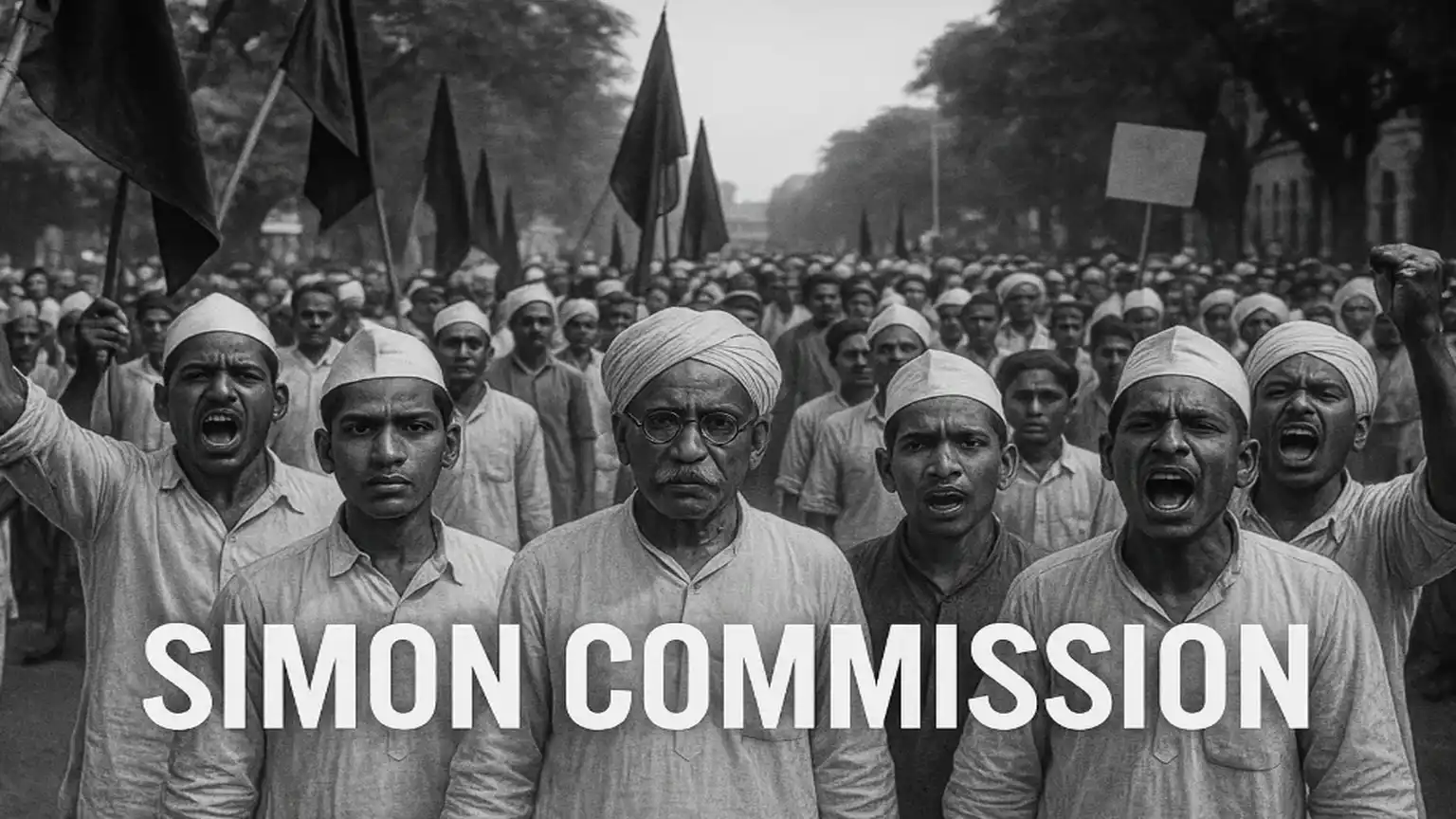The Montagu-Chelmsford Reforms of 1919 had promised that a review of the constitutional progress in India would be undertaken after ten years. The objective was to assess how far the reforms had succeeded and what further changes were necessary in India’s governance. However, political developments in India led the British Government to expedite this process. The clause “at the expiration of ten years” in Section 84A of the Government of India Act was replaced with “within ten years”, allowing for early action. As a result, the Simon Commission was formed in advance of the expected timeline, triggering political controversy across India.
On November 26, 1927, the British Government appointed the Simon Commission, a seven-member statutory body chaired by Sir John Simon. Other members included Viscount Burnham, Baron Strathcona, Edward Cadogan, Vernon Hartshorn, Richard Lane-Fox, and Clement Attlee. Importantly, the Commission did not include a single Indian, which became a major point of contention.
Purpose of Simon Commission and its Premature Appointment
The Commission’s task was to recommend constitutional reforms for India. Its premature appointment was politically motivated:
- The Conservative Party feared that the Labour Party, which was sympathetic to Indian self-rule, might win the 1929 elections and use the Indian issue for political advantage.
- The government also aimed to counter the growing criticism from Indian parties such as the Swaraj Party, led by C.R. Das and Motilal Nehru, which was actively challenging British rule in the Indian Legislative Assembly.
Interestingly, Quaid-i-Azam Muhammad Ali Jinnah, as early as March 11, 1926, had called for a commission under the 1919 Act, emphasizing that it should include individuals acceptable to the Indian people. However, the exclusion of Indians from the Simon Commission contradicted this demand and sparked outrage.
Nationwide Opposition and Boycott
The announcement of an all-British commission caused a wave of anger across India. Prominent leaders and parties condemned the Commission and announced their decision to boycott it. Among the most vocal critics were:
- Indian National Congress
- Jinnah-led All-India Muslim League
- All-India Khilafat Committee
- Hindu Mahasabha
- Bengal Muslim League
Dr. Mukhtar Ahmad Ansari, then Congress president, demanded the Commission’s withdrawal. Sir Tej Bahadur Sapru called it an insult to Indian national pride.
Jinnah remarked, “I cannot even imagine the appointment of a commission which does not contain even a single Indian member.” He emphasized that such a move must be boycotted totally. In a powerful telegram, he compared the Commission to the Jallianwala Bagh tragedy, stating:
“The Jallianwala Bagh was a physical butchery. The Simon Commission is the butchery of our souls.”
The slogan “Simon Go Back” became the rallying cry of Indian protests.
Division within the Muslim League
The appointment of the Commission caused a split in the Muslim League, dividing it into two factions:
- The Jinnah League, which opposed the Commission and demanded its boycott.
- The Shafi League, led by Mian Muhammad Shafi, which supported cooperation with the Commission.
A resolution in support of the boycott was passed by the Jinnah League in Calcutta on December 3, 1927, while the Punjab Muslim League held a pro-Commission session at Mian Shafi’s residence on November 13, 1927.
Interestingly, Allama Iqbal, although critical of the all-White composition, supported participation, calling the exclusion of Indians “unexpected, disappointing, and painful.” Other supporters included the Punjab Landlords Association, Chief Khalsa Diwan, Punjab Chiefs’ Association, and the Justice Party of Madras.
Simon Commission’s Visit and Widespread Protests
The Commission visited India twice:
- February 3 – March 31, 1928
- October 11, 1928 – April 13, 1929
Both visits were met with mass protests. Delegations were received under heavy police protection. Demonstrations erupted in every major city, and the slogan “Simon Go Back” echoed across the subcontinent.
One symbolic protest occurred in Lucknow, where pro-British taluqdars hosted a feast for the Commission. Protestors flew kites with the words “Simon Go Back” written on them, which were cleverly dropped near the gathering.
Lala Lajpat Rai and the Lahore Tragedy
On October 30, 1928, a major protest in Lahore turned violent. A large procession led by Lala Lajpat Rai, Zafar Ali Khan, and Abdul Qadir Qasuri marched from Mochi Gate to the railway station. Clashes broke out at Landa Bazar, and the police resorted to a baton charge. A British officer, James A. Scott, struck Lajpat Rai near the chest. He died a few days later from his injuries.
His death intensified anti-British sentiment and made him a martyr for Indian freedom.
Simon Commission Report and Recommendations
The Commission’s final report was published in May 1930 in two volumes:
- Volume 1: Analyzed India’s political, administrative, financial, and educational structures.
- Volume 2: Offered recommendations for constitutional reforms.
Major Recommendations
- Abolition of Dyarchy in provinces and full transfer of power to Indian ministers.
- Introduction of federalism with greater autonomy to provinces.
- Extension of voting rights to a larger population.
- A committee to examine separation of Sindh from Bombay Presidency.
- Rejection of separate electorates and denial of Frontier Province’s demand for equal status.
The report’s most controversial point was its opposition to Muslim demands for separate electorates and majority rule in Punjab and Bengal. The report famously stated that giving full rights in such a context would be like allowing a man to smoke in a “powder magazine.”
Muslim Response to Simon Commission Report
The report was unanimously rejected by Muslim leaders. Jinnah and Allama Iqbal both declared it unacceptable. Iqbal called it “a death blow” to Muslim political strength in Punjab. He and other leaders like Ch. Afzal Haq, Dr. Alam, and Abdul Qadir Qasuri proposed launching mass agitation.
Muslim newspapers like Inqilab, Siasat, and Muslim Outlook declared the report an imposition of Hindu Raj under British protection.
The All-Parties Muslim Conference also rejected the report, stating it was “unacceptable to the Muslims of India and retrograde in spirit.” The Conference demanded:
- Muslim majority in Punjab and Bengal
- Separation of Sindh
- Reforms in NWFP and Baluchistan
The Simon Commission episode became a landmark in India’s freedom struggle. It united various political factions against colonial rule and laid bare the British Government’s unwillingness to give Indians an equal voice in shaping their own future.
Although the Commission was ultimately rejected, it paved the way for the Nehru Report (1928) and later the Government of India Act 1935, which brought limited constitutional reforms. More importantly, it helped consolidate nationalist movements and strengthened the demand for complete independence.

